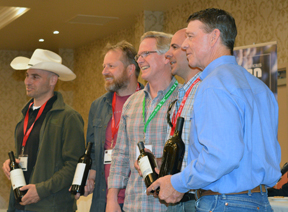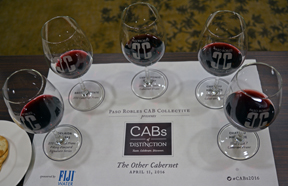I attended the Paso Robles Cab Collective “Cabs of Distinction” program at the Allegretto Vineyard Resort in Paso Robles. One session was about the other Cabernet focusing on Cabernet Franc. The panel included four winemakers and a moderator. Included on the panel were Bob Barth from Culinary Institute of America in Napa, Jeremy Weintraub, winemaker at Adelaide Cellars, Damian Grindley, winemaker at Brecon Estate, Anthony Riboli, winemaker at San Antonio Winery and Michael Mooney, winemaker at Chateau Margene.
During the panel discussion and tasting of the wines, major challenges to growing and making wine from Cabernet Franc were revealed. One challenge for this nobel grape that is a parent of Cabernet Sauvignon is that many consumers associate certain characteristics with Cabernet Franc. These traits include herbal and vegetative notes. Bob Barth was quick to point out that these characteristics are not associated with Cabernet Franc they are associated with underripe Cabernet Franc. These vegetative and herbal characteristics are caused by methoxy-pyrazine and to a certain degree can be reduced in the vineyard with certain practices. The winemakers on the panel made it known that they did not like these characteristics in underripe Cabernet Franc.
They are not alone. Living on the east coast, I’ve had the opportunity to taste many 100% Cabernet Francs that were easily very herbal and vegetative. The usual comment was that those traits was a common component of the grape. As a result, I did not use Cabernet Franc in a 2014 Bordeaux-style blend that Kathy and I have in barrel aging. I too do not like the pyrazine characteristics. I did taste one Cabernet Franc in souther Virginia that did not profile pyrazine characteristics, instead the most notable description was that of plums. So Cabernet Franc can achieve ripeness in some areas.
The panel discussed the need for Cabernet Franc to be planted in the best vineyard plot, a need that would probably cause the vineyardist to pull out Cabernet Sauvignon. This is unlikely to happen. There is an economic impact and Cabernet Sauvignon brings in more revenue both from the vineyard and in the winery. Cabernet Sauvignon fetches a higher price and demand than Cabernet Franc. The economics of planting Cabernet Franc and making wine with it is another challenge for this nobel grape.
A third challenge was how to market Cabernet Franc. One of the panelists simply said he pours it in the tasting room. However it is easier to sell other wines than Cabernet Franc. There are a few people that like the grape and are asking for it. But this is a small group.
The audience asked about a comparison between Cabernet Franc grown in Napa and Paso Robles. The panel took a position that there are good Cabernet Francs grown in each area as well as Cabernet Francs with the herbal vegetative characteristics.
What are you feelings about growing or making wine with Cabernet Franc?
Cheers,
Terry





Leave a Reply